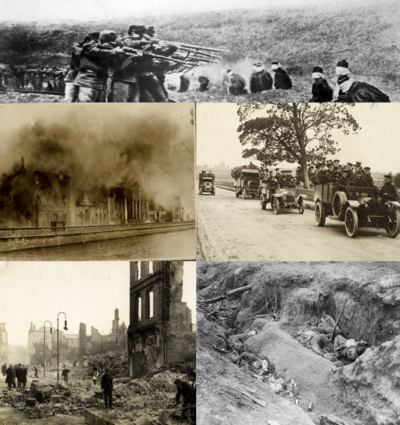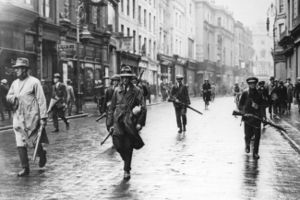Difference between revisions of "Second Gjorkan Civil War"
| (10 intermediate revisions by the same user not shown) | |||
| Line 51: | Line 51: | ||
}} | }} | ||
| − | The [[Second Gjorkan Civil War]] ([[Gjorkan]]: ''Dara Cogadh Cathartha Gjorkan'') was an armed conflict in [[Gjorka]] fought initially between the [[First Gjorkan Republic|Government Loyalists]] and the [[Gjorkan Revolutionary Government|Revolutionaries]]. Later the conflict became a three sided war when the [[People's Republic of Gjorka|Socialists]] joined the war following the [[1917 Gjorkan coup d'etat|overthrow of the revolutionary government]]. The war is the bloodiest conflict in Gjorkan history, and saw the deaths of nearly 2.4 million soldiers and over 400 thousand civilians. | + | The [[Second Gjorkan Civil War]] ([[Gjorkan]]: ''Dara Cogadh Cathartha Gjorkan'') was an armed conflict in [[Gjorka]] fought initially between the [[First Gjorkan Republic|Government Loyalists]] and the [[Gjorkan Revolutionary Government|Revolutionaries]]. Later the conflict became a three sided war when the [[People's Republic of Gjorka|Socialists]] joined the war following the [[1917 Gjorkan coup d'etat|overthrow of the revolutionary government]]. The war is the bloodiest conflict in Gjorkan history, and saw the deaths of nearly 2.4 million soldiers and over 400 thousand civilians, approximately 7% of the Gjorkan population at the time. |
== Background == | == Background == | ||
| + | === First Gjorkan Republic === | ||
| + | {{main|First Gjorkan Republic}} | ||
| + | |||
| + | The [[First Gjorkan Republic]] was established in 1775 following the end of the [[First Gjorkan Civil War]] and the dissolution of the [[Third Gjorkan Kingdom|Gjorkan monarchy]]. The First Republic was initially established as a parliamentary republic with the [[Congress of Gjorka]] serving as the democratically elected legislature. The only other main body within the First Republic's government was the [[High Court of Gjorka]], a court of six judges who oversaw the country's judicial system. | ||
| + | |||
| + | Throughout the First Republic's early years, it maintained a stable parliamentary democracy with a relatively stable separation of power between the High Court and the Congress. However, tension began to rise within the Congress as two factions began forming. The Merchant faction represented the ruiling merchant aristocracy of the country who had taken power in the civil war, while the Commoner faction represented the working class of the nation, particularly farmers. As the Commoner faction began accruing more seats in the Congress, the Merchant controlled High Court began to take more power for themselves, including the ability to rule laws passed by the Congress as "unconstitutional". | ||
| + | |||
| + | This tensions between the Commoners and the Merchants eventually boiled over in the [[1850 Gjorkan general election|1850 election]] which saw the [[Gjorkan Party]] (a Commoner party) gain a majority in the Congress over the [[National Party (Gjorka)|National Party]] (a Merchant party). The High Court, fearing the power of a Commoner-controlled Congress, issued a decree dissolving the Congress and declared the [[Gjorkan Party]] to be a treasonous organization. Most of the Congress were arrested by local police and military units and the Commoners were unable to mount a sufficient response to the High Court's coup leading to the creation of an oligarchical dictatorship. | ||
| + | |||
| + | === Rising Tensions === | ||
| + | {{see also|Gjorkan revolutionary period|Gjorkan Labor Wars}} | ||
| + | |||
=== Blue Revolution === | === Blue Revolution === | ||
{{Main|Blue Revolution}} | {{Main|Blue Revolution}} | ||
| − | |||
| − | == Early | + | == Early war == |
[[File:Prisoner (6417469255).jpg|thumb|left|Soldiers leaving to join the Revolution]] | [[File:Prisoner (6417469255).jpg|thumb|left|Soldiers leaving to join the Revolution]] | ||
| − | === The 40 | + | === The 40 days === |
| − | + | === First year === | |
| − | |||
| − | === First | ||
| − | |||
| − | |||
== The Long Death == | == The Long Death == | ||
| + | === Northern Front === | ||
| + | === Southern Front === | ||
| + | === Carrauntoohil Skirmishes === | ||
| − | == Late | + | == Late war == |
| − | === Socialist | + | === Socialist split === |
{{See also|1917 Gjorkan coup d'etat}} | {{See also|1917 Gjorkan coup d'etat}} | ||
[[File:1917GjorkaCoupPatrol.jpeg|thumb|Revolutionary Soldiers patrolling the street following the Coup d'etat]] | [[File:1917GjorkaCoupPatrol.jpeg|thumb|Revolutionary Soldiers patrolling the street following the Coup d'etat]] | ||
| − | |||
=== Surrender of the Loyalists === | === Surrender of the Loyalists === | ||
| − | |||
| − | |||
[[File:NomakoaDestoryed.jpeg|200px|thumb|left|Nomakoa following it's capture by Revolutionary Forces]] | [[File:NomakoaDestoryed.jpeg|200px|thumb|left|Nomakoa following it's capture by Revolutionary Forces]] | ||
=== The Final Offensive === | === The Final Offensive === | ||
| − | |||
| − | |||
== Atrocities == | == Atrocities == | ||
| Line 90: | Line 95: | ||
=== Socialist === | === Socialist === | ||
| − | == Foreign | + | == Foreign support == |
== Aftermath == | == Aftermath == | ||
Latest revision as of 16:36, 5 July 2023
| Second Gjorkan Civil War | ||||||||
|---|---|---|---|---|---|---|---|---|
 (Clockwise from top) Execution of deserters by Loyalist Forces, Volunteers leaving to join the Revolutionary Fight, Captured Trench filled with dead Socialists, Ruins of Nomakoa following the capture of the city by Revolutionary Forces, Burning of the Gjorkan Royal Palace as Revolutionary and Loyalist Forces fight for control of Gjorka City . | ||||||||
| ||||||||
| Belligerents | ||||||||
|
| |||||||
| Commanders and leaders | ||||||||
|
|
|
| ||||||
| Strength | ||||||||
| 3,100,000 soldiers (peak) | 6,000,000 soldiers (peak) | 2,000,000 soldiers (peak) | ||||||
| Casualties and losses | ||||||||
|
900,000 dead 3,500,000 wounded |
1,000,000 dead 4,500,000 wounded |
500,000 dead 1,000,000 wounded | ||||||
| Civilians: 400,000 dead, Unknown wounded | ||||||||
The Second Gjorkan Civil War (Gjorkan: Dara Cogadh Cathartha Gjorkan) was an armed conflict in Gjorka fought initially between the Government Loyalists and the Revolutionaries. Later the conflict became a three sided war when the Socialists joined the war following the overthrow of the revolutionary government. The war is the bloodiest conflict in Gjorkan history, and saw the deaths of nearly 2.4 million soldiers and over 400 thousand civilians, approximately 7% of the Gjorkan population at the time.
Contents
Background
First Gjorkan Republic
The First Gjorkan Republic was established in 1775 following the end of the First Gjorkan Civil War and the dissolution of the Gjorkan monarchy. The First Republic was initially established as a parliamentary republic with the Congress of Gjorka serving as the democratically elected legislature. The only other main body within the First Republic's government was the High Court of Gjorka, a court of six judges who oversaw the country's judicial system.
Throughout the First Republic's early years, it maintained a stable parliamentary democracy with a relatively stable separation of power between the High Court and the Congress. However, tension began to rise within the Congress as two factions began forming. The Merchant faction represented the ruiling merchant aristocracy of the country who had taken power in the civil war, while the Commoner faction represented the working class of the nation, particularly farmers. As the Commoner faction began accruing more seats in the Congress, the Merchant controlled High Court began to take more power for themselves, including the ability to rule laws passed by the Congress as "unconstitutional".
This tensions between the Commoners and the Merchants eventually boiled over in the 1850 election which saw the Gjorkan Party (a Commoner party) gain a majority in the Congress over the National Party (a Merchant party). The High Court, fearing the power of a Commoner-controlled Congress, issued a decree dissolving the Congress and declared the Gjorkan Party to be a treasonous organization. Most of the Congress were arrested by local police and military units and the Commoners were unable to mount a sufficient response to the High Court's coup leading to the creation of an oligarchical dictatorship.
Rising Tensions
Blue Revolution
Early war
The 40 days
First year
The Long Death
Northern Front
Southern Front
Carrauntoohil Skirmishes
Late war
Socialist split
Surrender of the Loyalists
The Final Offensive
Atrocities
Loyalist
Revolutionary
Socialist
Foreign support
Aftermath
Legacy
Film
The War was depicted a number of times during the military government in use as propaganda films. Following the Black Revolution, and the re-establishment of democracy the war became a taboo subject in film making. A big budget film about the war wasn't produced until 2019 when 1917 was released which grossed over a billion pón making it the highest grossing film that year.



